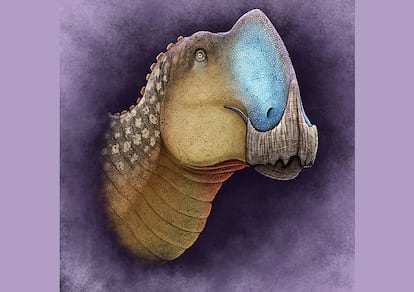A new herbivore identified in Coahuila, northern Mexico, sheds new light on the wide diversity of dinosaurs that inhabited the country and the environment in which they developed some 72 million years ago. The discovery, made by an international team of scientists from the remains of a skull and jaws collected previously, allowed the identification for the first time of a new species, Coahuilasaurus lipani, a dinosaur from the group of hadrosaurids (popularly called duckbills), which was about eight meters long, walked on four legs and lived in North America about seven million years before the Cretaceous–Paleogene extinction event that wiped the dinosaurs out.
Unlike typical paleontology discoveries, the fossil remains of Coahuilasaurus lipani, discovered in the late 1980s, remained classified and displayed for decades as those of a Kritosaurus, a genus of duck-billed dinosaur native to New Mexico in the southern United States. At the beginning of 2023, however, a team of Mexican, British and American paleontologists began examining the skull remains in search of verification. “A series of questions arose and that is when we decided to redescribe this specimen. We began to compare it to Kritosaurus and said to ourselves ‘it is definitely not this; it’s something else, it’s another duckbill,’ and due to its unique characteristics, we realized that it was something new,” Claudia Serrano Brañas, Mexican paleontologist and co-author of the study published in September 2024, explains to this newspaper.
The Coahuilasaurus remains were discovered in Cerro del Pueblo, a geological formation located in the south of Coahuila, which has become a true window into the state’s remote past due to the diversity of fossil records of primitive flora and fauna. Serrano states that 72 million years ago, the semi-desert landscape of the region was very different from today: instead of a dry climate, a tropical forest with dense vegetation extended to the coast through swamps and bays that created a unique fossil record. The study of this geological formation in the mid-1990s sparked the paleontology boom in Mexico and with it, the discovery of the first dinosaurs described in the country.
The key to considering the specimen a new species lies in the bony structures that form the front of the snout. Unlike the three other duckbills found in Coahuila, the bones that formed the palate and jaw of Coahuilasaurus lipani revealed a conical structure unprecedented in hadrosaurs, adapted to crush particularly resistant vegetation. This detail led Serrano and her colleagues to suggest that, unlike the other duckbills found in the state, Coahuilasaurus fed on palm leaves and tougher plants, a hypothesis that fits perfectly with the environment and the species identified so far in the region.
 An artist’s reconstruction of ‘Coahuilasaurus lipani.’ C. Díaz FríasA new piece in the American prehistoric puzzle
An artist’s reconstruction of ‘Coahuilasaurus lipani.’ C. Díaz FríasA new piece in the American prehistoric puzzle
Serrano, a researcher associated with the Benemérita Escuela Normal de Coahuila and a professor at the University of Geological and Social Sciences, says that recent findings in Mexico are changing the notion that was held in the past about the species of dinosaurs that expanded throughout the Americas, a region studied in depth from the United States and Canada, but with countless incipient investigations underway in Mexico and the rest of Latin America.
“Previously, Mexico was not even thought to have dinosaurs. There was this idea that the dinosaurs in the north of the country were most likely the same as those found in the United States, even Canada. But when we studied them in more detail, we realized that the dinosaur fauna in Mexico is completely different from what we had found,” says Serrano. “We are seeing great diversity and a very high degree of endemism. The thing is that it had hardly been studied, and everything pointed towards the United States and southern Canada […] we are changing that mentality that everything was North American.”
Sign up for our weekly newsletter to get more English-language news coverage from EL PAÍS USA Edition
Source link : http://www.bing.com/news/apiclick.aspx?ref=FexRss&aid=&tid=67052210afb745b78c0011938c70c007&url=https%3A%2F%2Fenglish.elpais.com%2Fscience-tech%2F2024-10-08%2Fcoahuilasaurus-lipani-the-new-dinosaur-species-discovered-in-northern-mexico.html&c=10505195841647130959&mkt=en-us
Author :
Publish date : 2024-10-08 00:57:00
Copyright for syndicated content belongs to the linked Source.








